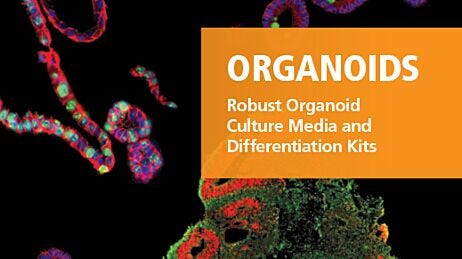Your Lung Research Needs Physiologically
Relevant Models
ATS 2021 Virtual Conference Exhibition
As pulmonary research progresses, you can stay up to date on the latest advances by listening to experts discuss their research, learning about new products/services, and connecting with peers online. Whether you’re attending ATS 2021 virtually from May 14 - 19 or just want to see what’s new in pulmonary research, explore these curated tools and resources to help you model the human lung in vitro, including protocols and webinars on lung organoids and air-liquid interface (ALI) cultures.
Bookmark this page and follow @STEMCELLTech on Twitter for updates.
Studying Lung Disorders with Organoids
Human lung organoids, in vitro model systems that mimic the in vivo lung, are a powerful tool for studying lung biology, modeling disease, and rapidly developing treatments against respiratory pathogens. Learn how and why you should incorporate this organoid culture system in your research by browsing the resources below.
Pulmonary Organoids Learning Center
Learn about using an organoid culture system for in vitro lung modeling in this collection of protocols, webinars, and other scientific resources.
Wallchart: Dynamic Modeling in Organoids
Receive a free copy of this wallchart on the applications of organoids for studying human health, developed by Cell Stem Cell in collaboration with STEMCELL Technologies.
Organoids: Experts Talk Standardization
Experts agree that to fully realize the utility of organoids a certain level of standardization is needed both within and between labs. Gain key insights from their discussions and watch the presentations from our Nature Research Round Table.
Organoid Research Techniques: Evolution and Applications
Learn about the evolution of organoid techniques, from their original development and description to updated applications and future outlooks, by downloading this detailed e-book.
Model the Human Airway at the Air-Liquid Interface
Primary human bronchial epithelial cells (HBECs) can be expanded and differentiated at the ALI to obtain a pseudostratified mucociliary epithelium that closely mimics what is observed in vivo. Watch the following protocol videos to learn how you can culture HBECs at the ALI and find helpful resources for their characterization below.
ALI Culture Protocol
Get an overview of the ALI culture workflow in this introductory video, or dive right into the step-by-step protocols by following the links below.
Expansion of Human Airway Epithelial Cells >
Differentiation of Human Airway Epithelial Cells >
Resources for Characterizing ALI Cultures
Model Cystic Fibrosis Airways
Technological advances have enabled researchers to study cystic fibrosis (CF) using specialized in vitro cell culture models, such as ALI cultures of primary human airway epithelial cells. Learn more about studying CF with airway epithelial cells by exploring the resources below.
Studying Cystic Fibrosis with ALI Cultures
See the side-by-side performance data for different commercially available expansion and differentiation media for culturing CF airway epithelial cells at the ALI.
Webinar: Studying Cystic Fibrosis Using Primary Human Nasal Epithelial Cells
Explore the advantages of using nasal epithelial cell cultures, including their relevance to patients, and their implications for precision medicine in CF in this webinar by Dr. Theo Moraes.
Researchers considering three-dimensional (3D) models can also use patient-derived organoids to study CF. Airway organoids cultured using PneumaCult™ Airway Organoid Kit demonstrate suitability for monitoring cystic fibrosis transmembrane conductance regulator (CFTR) function using the forskolin-induced swelling assay. See the data >

ATS 2021 Virtual: Prize Draw
We hope you enjoyed ATS 2021! This contest is now closed.
Study COVID-19 with ALI Cultures
Studying how viruses infect the airway tissue tissues helps researchers understand how to intervene and treat infected patients. To date, the ALI culture system has been used to study a wide range of pathogens, including the SARS-CoV-2 virus.
Learn how and why researchers are using ALI cultures to study respiratory viral infections, including COVID-19.
Join the Conversation
Follow us on Twitter @STEMCELLTech to be the first to know about upcoming conferences, webinars, and products.
Discover New and Upcoming Products for Respiratory Research
Explore our new and upcoming cell culture media designed to help you model the human lung in vitro and study respiratory diseases.
PneumaCult™ Airway Organoid Kit
Grow airway organoids to study lung biology and infectious diseases in vitro, using a cell culture insert-free protocol.
Related Webinar:
In Vitro Human Airway Modeling Using Primary Airway Epithelial Cells
New: STEMdiff™ Branching Lung Organoid Kit
Generate organoids—featuring proximal and distal-like branching structures of the human lung—from human pluripotent stem cells using the new STEMdiff™ Branching Lung Organoid Kit.
Related Webinar:
Making Lung Cells from Pluripotent Stem Cells: Disease Modeling and Future Therapies
STEMdiff™ Lung Progenitor Kit
Generate lung progenitor cells from human embryonic stem (ES) and induced pluripotent stem (iPS) cells using a specialized serum-free medium system.
Related Webinar:
Derivation and Applications of Human Pluripotent Stem Cells
PneumaCult™ Culture System for Culturing Human Airway Epithelial Cells
Interested in learning more about these products or how we can help support your research? Leave us a message >
Get a Free Respiratory System Wallchart
Overview of the Respiratory System
Get a complimentary wallchart for an organizational and functional overview of the respiratory system.
Watch Our Latest Webinars
Watch our scientific talks and presentations on demand.
























